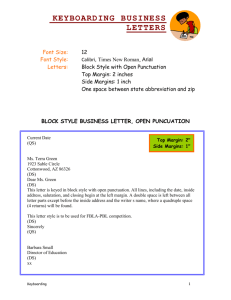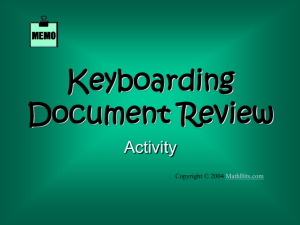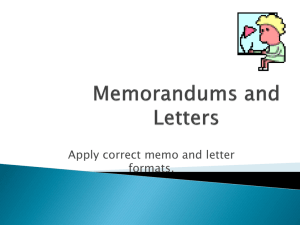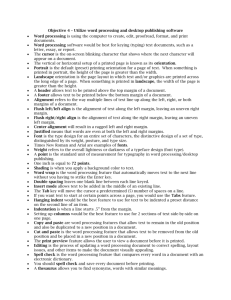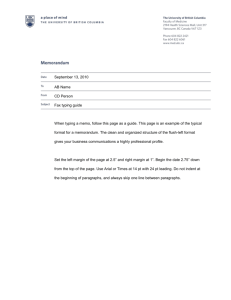BUSINESS LETTERS
advertisement
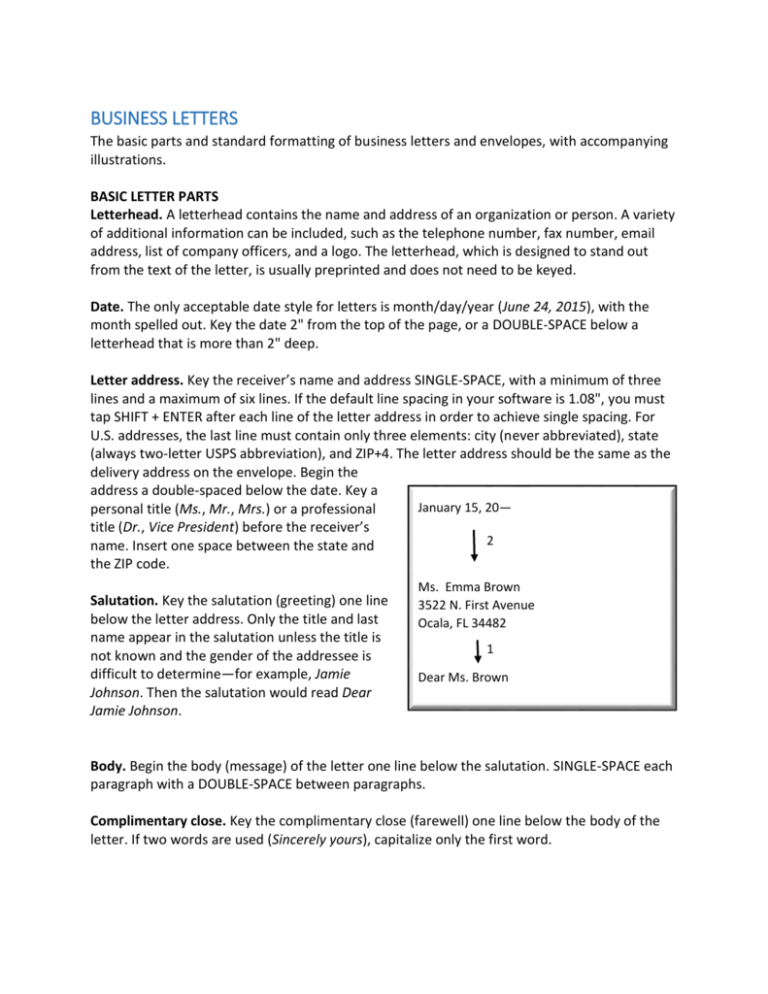
BUSINESS LETTERS The basic parts and standard formatting of business letters and envelopes, with accompanying illustrations. BASIC LETTER PARTS Letterhead. A letterhead contains the name and address of an organization or person. A variety of additional information can be included, such as the telephone number, fax number, email address, list of company officers, and a logo. The letterhead, which is designed to stand out from the text of the letter, is usually preprinted and does not need to be keyed. Date. The only acceptable date style for letters is month/day/year (June 24, 2015), with the month spelled out. Key the date 2" from the top of the page, or a DOUBLE-SPACE below a letterhead that is more than 2" deep. Letter address. Key the receiver’s name and address SINGLE-SPACE, with a minimum of three lines and a maximum of six lines. If the default line spacing in your software is 1.08", you must tap SHIFT + ENTER after each line of the letter address in order to achieve single spacing. For U.S. addresses, the last line must contain only three elements: city (never abbreviated), state (always two-letter USPS abbreviation), and ZIP+4. The letter address should be the same as the delivery address on the envelope. Begin the address a double-spaced below the date. Key a January 15, 20— personal title (Ms., Mr., Mrs.) or a professional title (Dr., Vice President) before the receiver’s 2 name. Insert one space between the state and the ZIP code. Salutation. Key the salutation (greeting) one line below the letter address. Only the title and last name appear in the salutation unless the title is not known and the gender of the addressee is difficult to determine—for example, Jamie Johnson. Then the salutation would read Dear Jamie Johnson. Ms. Emma Brown 3522 N. First Avenue Ocala, FL 34482 1 Dear Ms. Brown Body. Begin the body (message) of the letter one line below the salutation. SINGLE-SPACE each paragraph with a DOUBLE-SPACE between paragraphs. Complimentary close. Key the complimentary close (farewell) one line below the body of the letter. If two words are used (Sincerely yours), capitalize only the first word. Name of the writer. Key the name of the writer (sender) two lines below the complimentary close. Generally the personal title of the writer is not included; however, a title can precede the name if a female prefers (Mrs., Miss, Ms.) or if the gender of the writer is unclear (Ms. Jamie Johnson). A business title or department may be added below the name of the writer. Sincerely yours Reference initials. If someone other than the writer keys the letter, add his or her initials in lowercase letters at the left margin two lines below the writer’s name, title, or department. 2 Tom Jones Executive Director 1 is SPECIAL LETTER PARTS In addition to the basic parts, a business letter may include special letter parts as described below. Mailing and addressee notations. Mailing notations such as REGISTERED or SPECIAL DELIVERY and addressee notations such as CONFIDENTIAL and PERSONAL may be included in a letter. Key these notations in ALL CAPS one line below the date and one line above the mailing address. Attention line. If the writer does not know the name of the receiver of the letter or is writing the letter to an organization, an attention line is keyed as the first line of the letter address. For example, Attention Director of Human Resources would be keyed on the first line; the company name would be keyed on the second line. When an attention line is used, the salutation should read Ladies and Gentlemen. January 15, 2015 1 CONFIDENTIAL 1 Ms. Emma Brown 3522 N. First Avenue Ocala, FL 34482 Attention Vice President of Sales Ford Motor Company 4785 State Road 200 Raleigh, VA 20110-2701 1 Ladies and Gentlemen Subject line. A subject line (optional) is used to identify the main topic discussed in the letter. Key the subject line in ALL CAPS one line below the salutation. Mr. Charles Smith 8852 Noel Drive Columbus, GA 40070-8471 ↓1 Dear Mr. Smith ↓1 CHRISTMAS PARTY ↓1 Attachment/Enclosure notation. If another document is stapled or clipped to a letter, the word Attachment is keyed one line below the reference initials. If a document is included with the letter but not attached, the word Enclosure is used. If reference initials are not used, the Attachment or Enclosure notation is keyed one line below the writer’s name. tj If more than one enclosure is included, the word ↓1 Enclosures or Enclosures # (see example) is used. Enclosures 2 Some companies prefer to identify each enclosure so there is no uncertainty over what is included with the letter. Copy notation. A copy notation indicates that a copy of the letter is being sent to someone besides the addressee. Key c and tab once, then key the name(s) of the person(s) who are to receive a copy. Place the copy notation one line below the enclosure notation, or if no enclosure is included, one line below the reference initials. Sometimes the writer of the letter wants to send a copy to someone without disclosing this to the addressee of the letter. In this case, key bc (blind copy) and tab once, then key the name(s). The blind copy notation is keyed on every copy, but not on the original letter. jc ↓1 Enclosure ↓1 c Mary Albertson Keyed on original and copy mm ↓1 bc Michael Blackburn Keyed on copy only PERSONAL-BUSINESS LETTERS TM 2" A letter written by an individual concerning business of a personal nature is called a personal business letter. All the parts of a business letter are included, with one exception: The letterhead is replaced with a return address. A personal business letter is printed on plain paper with the writer’s address keyed 2" from the top of the page at the left margin. The return address consists of one line for the street address and one line for the city, state, and ZIP code. The date is keyed directly below the city, state, and ZIP code. 221 Pine Street Seattle, WA 43612-0851 January 2, 2016 ↓2 Dr. Tyree James 872 Lakewood Drive Seattle, WA 43610-0610 Dear Dr. James Formats and styles: Margins TM (top margin) 2” LM (left margin) 1” RM (right margin) 1” BM (bottom margin) 1” Instead of a 2" top margin, letters may be centered vertically using the Center Page feature. Letters are formatted with 1" left and right margins, a 2" top margin, and a 1" bottom margin. Formats - Business letter are formatted in two basic styles: block and modified block. ■ Block format arranges all letter parts at the left margin. The paragraphs are not indented. ■ Modified block format places the date and the closing lines (complimentary close, writer’s name, and title) beginning near the horizontal center of the page instead of at the left margin. The default tab nearest to the center may be used to place the date and closing lines. The first line of each paragraph may be blocked at the left margin or indented 0.5". Punctuation styles - Two styles of punctuation are commonly used in business letters. Open punctuation has no punctuation mark after the salutation or complimentary close. Mixed punctuation contains a colon (:) after the salutation and a comma (,) after the complimentary close. Dear Mr. Smith Dear Mr. Smith: Sincerely yours Open Punctuation Sincerely yours, Mixed Punctuation ADDITIONAL LETTER FEATURES Some additional letter features that may be used are. USPS letter address style. The letter address of a business or personal-business letter may be keyed in ALL CAPS with no punctuation if using the United States Postal Service style for the delivery (envelope) address. Second-page heading. If a letter is longer than one page, a plain sheet of paper is used for the second and succeeding pages. Only the first page contains the sender’s letterhead. A secondpage heading should be keyed 1" from the top of the page in block format, SS. Include the name of the addressee, the word Page followed by the page number, and the date. DS below the date before continuing the letter. Widow/Orphan. At least two lines of a paragraph must appear at the bottom of the first page of a letter and at the top of the second page. Activate the Widow/Orphan feature to ensure proper breaks. Bullets and Numbering. Use the Bullets feature or Numbering feature to create bulleted or numbered lists. These features automatically format each listed item in hanging indent style (the second and succeeding lines align under the first letter of the first word). Basic letter parts are letterhead, date, letter address, salutation, body, complimentary close, writer’s name, and reference initials. Business letter formats are block, modified block with paragraph indentation, and modified block without paragraph indentation. Bulleted items Tables in letters. A table inserted in a letter should be placed even with the left and right margins of the letter or centered between the margins. Leave a blank line above and below the inserted table. Table gridlines may be shown or hidden. Form letters. A form letter is a standard message sent to more than one addressee. Form paragraphs may be stored as macros (stored text) and played back when needed to create personalized form letters. Form letters can also be created using the Mail Merge feature of word processing programs. Personal-Business Letter in Block Format with Open Punctuation ENVELOPES Most word processing programs have an Envelope feature that will automatically format the placement of the return and letter addresses. However, because of printer issues, not all users are able to use the Envelope feature efficiently. Therefore, specific keying instructions are provided below for formatting envelopes. Sender’s return address. Key the return address in block style, SS, approximately 0.25" from the left and top margins of the envelope. Key the name, street address, city, state, and ZIP Code in three lines either in ALL CAPS or Initial Caps. Receiver’s address. Key the receiver’s address in block style, SS, and Initial Caps. You may use ALL CAPS if desired. Place the city, state, and ZIP Code (one space precedes the ZIP) on the last address line. Never abbreviate the name of a city or country. International addresses. Omit postal (ZIP) codes from the last line of addresses outside the U.S. Show only the name of the country on the last line, as shown below. Mr. Hiram Sanders 2121 Clearwater Street Ottawa ON KIA OB1 CANADA Spacing. If not using the Envelope feature, tab over 2.5" for a small envelope (No. 63⁄4) and 4" for a large envelope (No. 10). Enter hard returns to place the first line of the delivery address approximately 2" from the top of the envelope. Mailing and addressee notations. Key a mailing notation (REGISTERED, SPECIAL DELIVERY) in ALL CAPS below the stamp, approximately 1⁄2" above the first line of the delivery address. Key an addressee notation (PERSONAL, CONFIDENTIAL) at the left margin a DS below the return address. If an attention line is used, key it as the first line of the delivery address. Magic Kingdom 1180 Seven Seas Dr. Lake Buena Vista, FL 32830 Roger Danes 2110 Pope Ave. Davenport, FL 33830-1234 Magic Kingdom 1180 Seven Seas Dr. Lake Buena Vista, FL 32830 Roger Danes 2110 Pope Ave. Davenport, FL 33830-1234 INTEROFFICE MEMOS Interoffice memorandums (memos) are used by employees within an organization to communicate with one another. A memo heading consists of four standard parts: TO, FROM, DATE, and SUBJECT. Memo margins. Top margin Side margins Bottom margin 2” 1” or default About 1” Spacing. Begin all lines of the heading at the left margin. Leave one space above and below each part of the heading and below the subject. Use default tabs as shown below. TO: Tab twice to key recipient’s name. ↓1 FROM: Tab twice to key sender’s name. ↓1 DATE: Tab twice to key date. ↓1 SUBJECT: Tab once to key subject. ↓1 Body. Begin all paragraphs of the memo at the left margin and key them SS with one blank line between paragraphs. Reference initials. If someone other than the originator keys the memo, the keyboard operator’s initials are keyed one line below the body of the memo. In addition to the standard parts, an interoffice memo may include the following special parts. Distribution list. When a memo is sent to more than one person, a distribution list is used. Format the TO heading as shown in the example below: TO: Susan Young Tracy Patterson Velvea Brown Irene Streeter Attachment/Enclosure notation. If another document is attached to a memo, the word Attachment is keyed at the left margin one line below the reference initials. If a document is included but not attached, the word Enclosure is used. If no reference initials are used, the notation is keyed one line below the last line of the body. Copy notations. A copy notation indicates that a copy of the memo is being sent to someone besides the addressee. Key c and tab once, then key the name(s) of the person(s) who are to receive a copy. Place the copy notation one line below the enclosure notation or the reference initials. Sometimes the writer of the memo wants to send a copy to someone without disclosing this to the addressee of the memo. In this case, key bc (blind copy) and tab once, then key the name(s).

